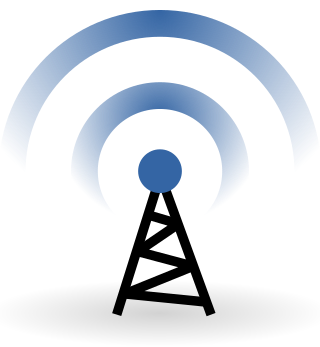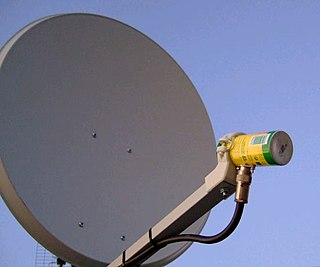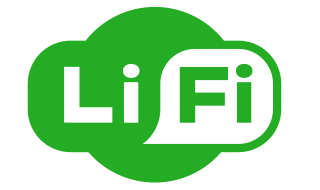Related Research Articles

A wireless LAN (WLAN) is a wireless computer network that links two or more devices using wireless communication to form a local area network (LAN) within a limited area such as a home, school, computer laboratory, campus, or office building. This gives users the ability to move around within the area and remain connected to the network. Through a gateway, a WLAN can also provide a connection to the wider Internet.

A wireless network is a computer network that uses wireless data connections between network nodes. Wireless networking allows homes, telecommunications networks, and business installations to avoid the costly process of introducing cables into a building, or as a connection between various equipment locations. Admin telecommunications networks are generally implemented and administered using radio communication. This implementation takes place at the physical level (layer) of the OSI model network structure.

Wireless community networks or wireless community projects or simply community networks, are non-centralized, self-managed and collaborative networks organized in a grassroots fashion by communities, non-governmental organizations and cooperatives in order to provide a viable alternative to municipal wireless networks for consumers.

Wi-Fi is a family of wireless network protocols based on the IEEE 802.11 family of standards, which are commonly used for local area networking of devices and Internet access, allowing nearby digital devices to exchange data by radio waves. These are the most widely used computer networks, used globally in home and small office networks to link devices and to provide Internet access with wireless routers and wireless access points in public places such as coffee shops, restaurants, hotels, libraries, and airports.

In computer networking, a wireless access point (WAP) is a networking hardware device that allows other Wi-Fi devices to connect to a wired network or wireless network. As a standalone device, the AP may have a wired or wireless connection to a switch or router, but in a wireless router it can also be an integral component of the networking device itself. A WAP and AP is differentiated from a hotspot, which can be a physical location or digital location where Wi-Fi or WAP access is available.

A cantenna is a homemade directional waveguide antenna, made out of an open-ended metal can.

A hotspot is a physical location where people can obtain Internet access, typically using Wi-Fi technology, via a wireless local-area network (WLAN) using a router connected to an Internet service provider.

Google WiFi was a municipal wireless network deployed in Mountain View, California. It was funded by Google and installed primarily on city lightposts. Google had committed to keeping the service free until 2010. The initial service was shut down by Google on May 3, 2014 at their Mountain View base, and provided a new public outdoor WiFi.

A municipal wireless network is a citywide wireless network. This usually works by providing municipal broadband via Wi-Fi to large parts or all of a municipal area by deploying a wireless mesh network. The typical deployment design uses hundreds of wireless access points deployed outdoors, often on poles. The operator of the network acts as a wireless internet service provider.

Cambium Networks Corporation is a wireless infrastructure provider that offers fixed wireless and Wi-Fi to broadband service providers and enterprises to provide Internet access. An American telecommunications infrastructure company, it provides wireless technology, including Enterprise WiFi, switching solutions, Internet of Things, and fixed wireless broadband and Wi-Fi for enterprises. Publicly traded on the NASDAQ stock exchange, it spun out of Motorola in October 2011.

Alvarion Technologies Ltd. is a global provider of autonomous Wi-Fi networks designed with self-organizing capabilities for carrier-grade Wi-Fi, enterprise connectivity, smart city planning, smart hospitality, connected campuses, and connected events.
Long-range Wi-Fi is used for low-cost, unregulated point-to-point computer network connections, as an alternative to other fixed wireless, cellular networks or satellite Internet access.

Boingo Wireless, Inc. is an American company that designs, builds and manages wireless networks. Its public and private networks include distributed antenna systems (DAS), small cells, macro towers and more than one million Wi-Fi hotspots around the world. The company operates networks for airports, transit stations, stadiums, military bases, hospitals and commercial properties. In December 2022, the company announced it was moving its headquarters to Frisco, Texas, and would maintain regional offices in Los Angeles, New York, Chicago and Las Vegas. The company was listed on the Nasdaq until it was acquired by investment firm Digital Colony Management LLC in 2021.

South African wireless community networks are wireless networks that allow members to talk, send messages, share files and play games independent of the commercial landline and mobile telephone networks. Most of them use WiFi technology and many are wireless mesh networks. A wireless community network may connect to the public switched telephone network and/or the Internet, but there are various restrictions on connectivity in South Africa. Wireless community networks are particularly useful in areas where commercial telecommunications services are unavailable or unaffordable.
Radwin is an Israeli wireless communications manufacturing company, a member of the RAD Group of companies.

The city of Minneapolis, Minnesota, is covered by a citywide broadband wireless internet network, sometimes called Wireless Minneapolis. The network was first proposed in 2003, at which point only a few other cities nationwide had such systems in place. Local firm US Internet beat out EarthLink to build and operate the network, with a guaranteed ten-year, multimillion-dollar contract from the city itself as the network's anchor tenant. Construction began on the project in 2006, but encountered several delays. Most of the city was covered by the network by 2010, and USI Wireless, the subsidiary of US Internet responsible for the system, set up numerous free internet access points at public locations around Minneapolis.

Li-Fi is a wireless communication technology which utilizes light to transmit data and position between devices. The term was first introduced by Harald Haas during a 2011 TEDGlobal talk in Edinburgh.

LinkNYC is an infrastructure project providing free Wi-Fi service in New York City. The office of New York City Mayor Bill de Blasio announced the plan on November 17, 2014, and the installation of the first kiosks, or "Links," started in late 2015. The Links replace the city's network of 9,000 to 13,000 payphones, a contract for which expired in October 2014. The LinkNYC kiosks were devised after the government of New York City held several competitions to replace the payphone system. The most recent competition, in 2014, resulted in the contract being awarded to the CityBridge consortium, which comprises Qualcomm; Titan and Control Group, which now make up Intersection; and Comark.
A Wi-Fi deauthentication attack is a type of denial-of-service attack that targets communication between a user and a Wi-Fi wireless access point.
Wi-Fi over Coax is a technology for extending and distributing Wi-Fi signals via coaxial cables. As an in-building wireless solution, Wi-Fi over Coax can make use of existing or new cabling with native impedance of 50 Ω shared by a Wi-Fi access point, cabling run, and antenna. Coaxial cables with characteristic impedance of 75 Ω, such as RG-6 cables used for in-building television distribution, can also be used by incorporating impedance converters. As part of a distributed antenna system, Wi-Fi over Coax can connect multiple floors of a home or office via power dividers and zoned antennas either passively or via amplifiers, potentially eliminating the need for multiple access points.
References
- ↑ "Managed Wireless". pinaclsolutions.com. Archived from the original on 10 March 2016. Retrieved 9 March 2016.
- ↑ Worsman, Charlotte. "City centre wi-fi". york.gov.uk. Retrieved 9 March 2016.
- ↑ "York LocalView for Wi-Fi". localview.york.gov.uk. Retrieved 9 March 2016.
- ↑ "New public wi-fi access for Aberdeen City Council buildings – Aberdeen City Council, Continuous Improvement". aberdeencity.gov.uk. Archived from the original on 25 April 2016. Retrieved 9 March 2016.
- ↑ "Free Public Wi-Fi – Aberdeen City Council, Continuous Improvement". aberdeencity.gov.uk. Archived from the original on 24 April 2016. Retrieved 9 March 2016.
- ↑ Solutions, Pinacl. "Visitors and Residents can now enjoy FREE unlimited WiFi whilst out and about in Newport City Centre". pinaclsolutions.com. Retrieved 9 March 2016.
- ↑ "Free WiFi at venues in Newport city centre". newport.gov.uk. Retrieved 9 March 2016.